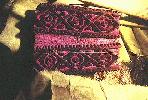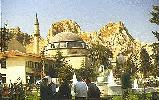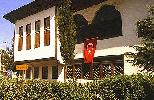| Tokat... |
|
A culturally rich settlement center, with traces of history all over the land, Tokat lies inland of the middle Black Sea
region, 422 kms from Ankara. Wandering in the city is an opportunity to catch a glimpse of life at old times, with the
many historical buildings at the numerous ancient sites. The most important figure here, is the Ottoman Citadel of 28
towers, founded on a rocky hill overlooking the town. The Garipler Mosque dating to the 12th century and the
Ali Pasa Mosque of 16th century constitute other sights worth visiting. One of Tokat's finest buildings is the
Gok Medresse (Pervane Bey Darussifasi) which was constructed in 1270. It was founded as a school of theology, and is now
converted into a museum, housing archaeological finds from the area. Two other notable monuments in this region, are the
Hatuniye Medresse of the 15th century, built by Sultan Beyazit, and a Seljuk bridge spanning the Yesilirmak
River, belonging to the 12th century. The Latifoglu Mansion is still another, which is a traditional Turkish
house of the 19th century, restored recently to its original state. 69 km northeast of Tokat, is Niksar, one
of the beautiful towns of the province, which carries important signs from the history of the country. It was once the
capital of the Turkish Danismend Emirs, and among the interesting sights are the well-preserved citadel, the Ulu Mosque,
and the 12th century Yagbasan Medresse. Zile is another ancient town, 67 kms west of the province, with its
fortress and the 13th century Ulu Mosque near it. This district has been the scene of many events of the
earliest ages too, and it was here that the Roman Emperor Julius Caesar said his famous words "Veni, Vidi, Vici";
"I came, I saw, I conquered". Resadiye is well known for its vast pine forests, hot springs, clays and natural
beauties. Ballica cave at Pazar is a natural wonder. The Dumanli meadows are the other famous places for resting and
refreshing. Tokat is at the cross-roads of ancient and old trade routes. There must have been some kind of early settlement
at the place where Tokat is today for the rocky hill top, now crowned by the remnants of the Seljuk/Ottoman castle, must
have played an important role as protector for the area around it. Archaeological excavations in town led to the discovery
of objects from the Bronze Age and the Hittite empire.
|
|

|


 356...
356...
 60...
60...
 828,027...
828,027...
 9,959...
9,959...
 36 E 43 - 40 N 19...
36 E 43 - 40 N 19...










